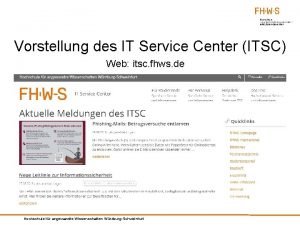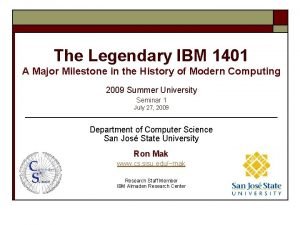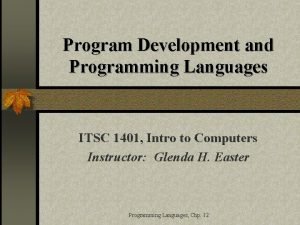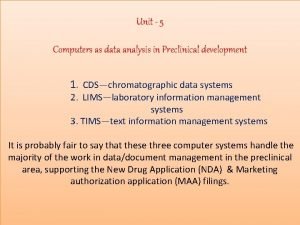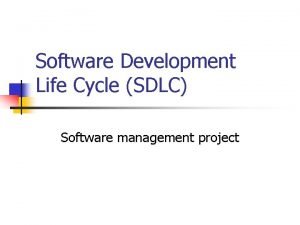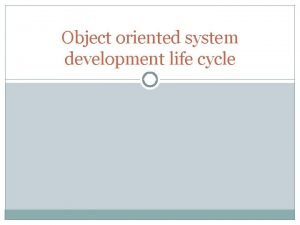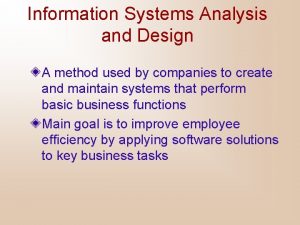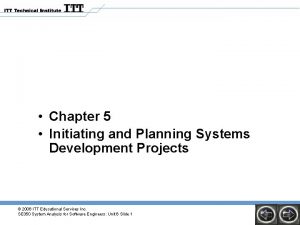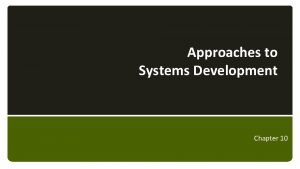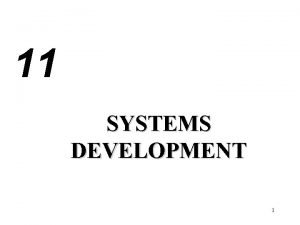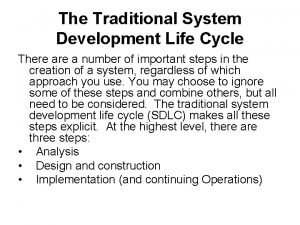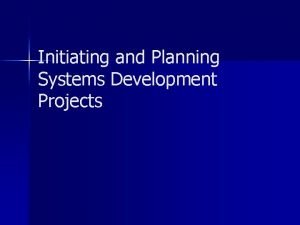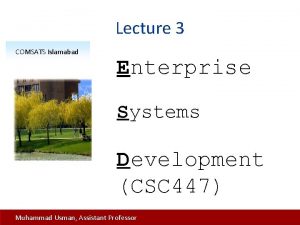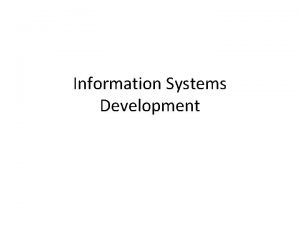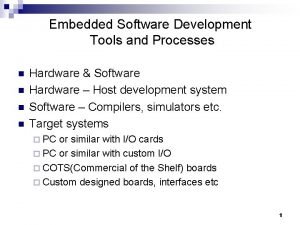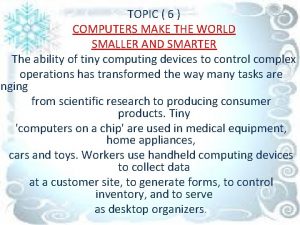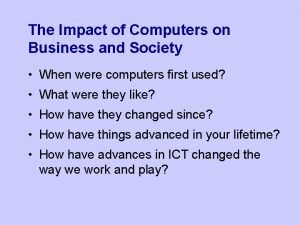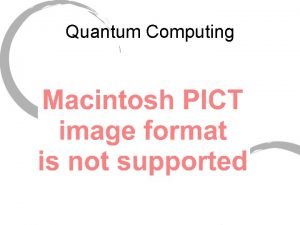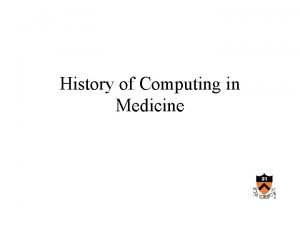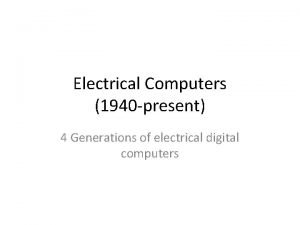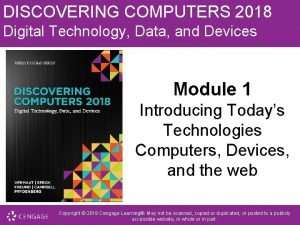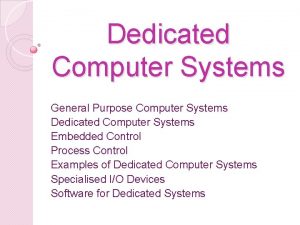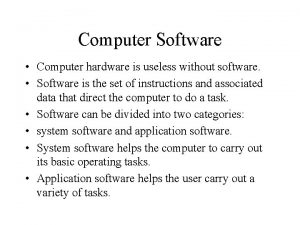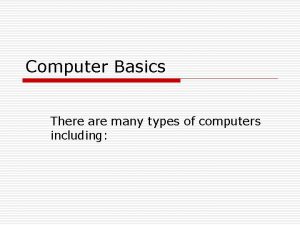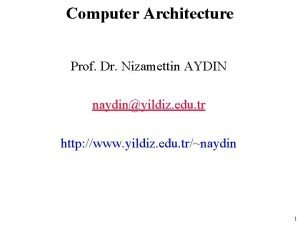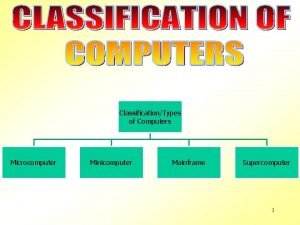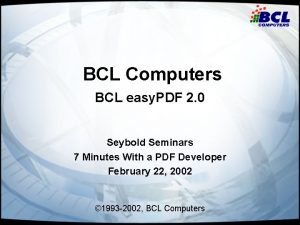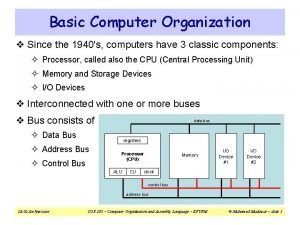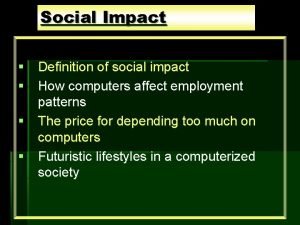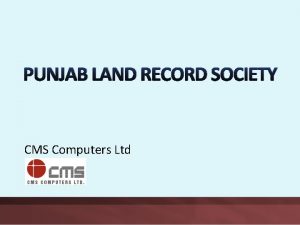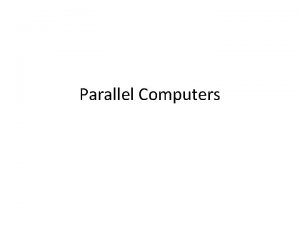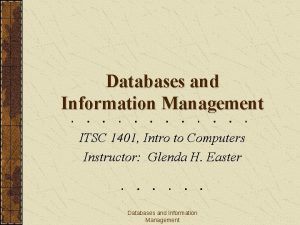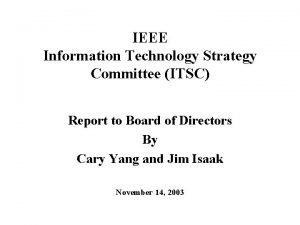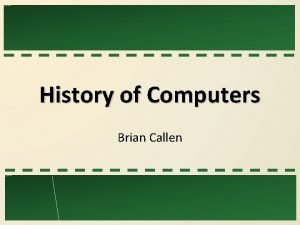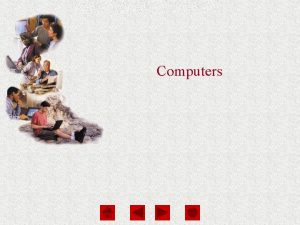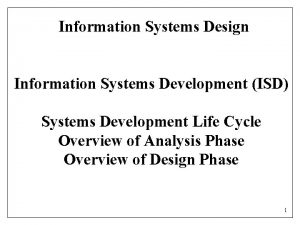Information Systems Development ITSC 1401 Intro to Computers














































































- Slides: 78

Information Systems Development ITSC 1401, Intro to Computers Instructor: Glenda H. Easter Information Systems Development, Chp. 11

Objectives n n n Explain the phases in the system development life cycle Identify the guidelines for system development Discuss the importance of project management, feasibility assessment, data and information gathering techniques and documentation Information Systems Development, Chp. 11 2

Objectives n n n Describe how structured tools such as entity-relationship diagrams and data flow diagrams are used in analysis and design Differentiate between packaged software and custom software Identify program development as part of the system development life cycle Information Systems Development, Chp. 11 3

Objectives n Discuss techniques used to convert to a new system and support an information system Information Systems Development, Chp. 11 4

A Few Terms, If You Please! n n A system is an organized way to accomplish one or more goals. The system model describes the sequence of input, processing, output, and storage. Computer systems that support businesses are called information systems. The people who design systems are called system analysts. Information Systems Development, Chp. 11 5

System Analysis and Design n n Systems should be established using a stepsystem, program-solving process known as system analysis and design. This is also known as the system life cycle. Information Systems Development, Chp. 11 6

Analysis and Design n Systems Analysis n n The study of an activity, a procedure, or an entire business Systems Design n The act of planning the technical aspects of the new system Information Systems Development, Chp. 11 7

System Development Life Cycle Preliminary Investigation Ø Analysis Ø Design/ Development Ø ØImplementation ØSupport (Maintenance and Documentation) Information Systems Development, Chp. 11 8

Five Phases of the Systems Development Life Cycle: (SDLC) n n n Preliminary Investigation: Needs Analysis Systems Design Development Implementation Maintenance

What Is The System Development Life Cycle? n Organized set of activities used to guide those involved through the development of an information system Information Systems Development, Chp. 11 10

System Analysis and Design n n Systems should be established using a stepsystem, program-solving process known as system analysis and design. This is also known as the system life cycle. Information Systems Development, Chp. 11 11

The System Life Cycle Information Systems Development, Chp. 11 12

Who Participates in the System Development Life Cycle? n Who participates in the system development life cycle? n Project team n Users n Information n n systems personnel Systems analyst Programmers n Steering committee Information Systems Development, Chp. 11 13

Who Participates in the System Development Life Cycle? Information Systems Development, Chp. 11 14

The Cycle Requires Project Management Tools n Project management n n Scope Project plan Gantt chart Deliverables Information Systems Development, Chp. 11 15

Project Management Tools Information Systems Development, Chp. 11 16

Data and Information Gathering Techniques Information Systems Development, Chp. 11 17

How Is Data Collected? n Data is gathered through. . . n n Observation Interviews Studying documents that describe the formal lines of authority in the organization, and its standard operating procedures. Reviewing the organizational chart and the levels of management and formal lines of authority. Information Systems Development, Chp. 11 18

Systems analysts spend much of their time interviewing users Information Systems Development, Chp. 11 19

What Initiates the System Development Life Cycle? n n n External reasons Internal reasons Project requests Information Systems Development, Chp. 11 20

Why Make Changes to an Information System? n Organizations may experience organizational growth. n There may be a merger or acquisition. n There may be new marketing opportunities. n Governmental regulations make be revised. n Availability of new technology may require changes. Information Systems Development, Chp. 11 21

Phase 1: Preliminary Investigation n n Define the Problem - what do we have and what do we need? Suggest alternative systems - develop a possible plan. Prepare a short report summarizing results of preliminary investigation and suggesting alternative systems. Determine the feasibility - Is there technology available to solve the problem? Cost/Benefit Analysis Information Systems Development, Chp. 11 22

Identifying the Problem & Opportunities To determine the problem, the system analyst talks to as many users as possible to discover what they do, when they do it, how they do it, and why. The analyst then recommends new system features or a new system. Information Systems Development, Chp. 11 23

Preliminary Investigation n Analysis: Preliminary Investigation Interviews n n n Questionnaires Submit feasibility study to the steering committee Recommend continue into the detailed analysis phase Information Systems Development, Chp. 11 24

Selecting the Best System n n Will the system fit in with the organization’s overall system? Will the system be flexible enough so it can be modified in the future? Can it be made secure against unauthorized use? Are the benefits worth the cost? Information Systems Development, Chp. 11 25

Phase 2: Analyzing & Documenting the Existing System Emphasis is on what the system should do Analyze the existing system Determine the new system’s requirements Information Systems Development, Chp. 11 26

Phase 2: Analysis of the Current System n n n During this phase, data is collected about the present system. The data is analyzed and new requirements are determined. The data is summarized in documentation. Information Systems Development, Chp. 11 27

Analysis of the Current System (Continued) n Detailed Analysis n n n Study the current system Identify the users’ wants, needs, and requirements Present alternative solutions Information Systems Development, Chp. 11 28

Writing the System’s Design Report for Upper Management n n n Compare the cost versus the benefits. What is the effect of alternative designs on the organization? Make recommendations for one of the alternatives. Information Systems Development, Chp. 11 29

How Is Data Analyzed? n n Data is analyzed to learn how information currently flows in the present system. There are tools used to analyze this data. They include: n n n Checklists – Top-Down Analysis Grid Charts – Decision Tables System _ Automated Design Flowcharts Tools Information Systems Development, Chp. 11 30

Analysis Phase n Structured Analysis and Design Tools n Entity-relationship diagrams (ERDs) Information Systems Development, Chp. 11 31

Analysis Phase n Structured analysis and design tools n Data flow diagrams (DFDs) Information Systems Development, Chp. 11 32

Tools Used During the Analysis Phase n A Checklist is a list of questions focusing on key issues of the present system. n Top-Down Analysis Methodology is similar to an organizational chart which identifies the top-level components of the system then breaks the components down further into smaller and smaller components for analysis. Information Systems Development, Chp. 11 33

Tools (Continued) n Grid Charts - A data table showing relationships between input and output documents. A checkmark at the intersection of a row and column would mean that the input document is used to create the output document. n System Flowcharts - shows the data or information flow into an information system. Information Systems Development, Chp. 11 34

Tools (Continued) n Automated Design Tools also known as Computer-Aided Software Engineering Tools (CASE) are software packages that evaluate hardware and software alternatives according to requirements given. CASE replaces line-by-line programming with a graphic and visual way to design programs. Information Systems Development, Chp. 11 35

Decision Tables n A data table showing the decision rules that apply when certain conditions occur. Information Systems Development, Chp. 11 36

Decision Trees Information Systems Development, Chp. 11 37

Program Design Tools Each box, or module, in a structure chart indicates a task that the program must accomplish Information Systems Development, Chp. 11 38

Program Design Tools Commission program Flowchart print headings get first salesperson A calculate commission print salesperson get next salesperson end of data A print total commission end A flowchart is a diagram that shows the logic of a program. Each flowcharting symbol has a meaning 39

Data Dictionary Information Systems Development, Chp. 11 40

Information Systems Development, Chp. 11 41

Analysis Phase n The Build-or-Buy Decision n n System proposal Packaged software n Already n developed software available for purchase Custom software n Application software developed by the user or at the user’s request Information Systems Development, Chp. 11 42

Interviewing and Reporting n n User involvement in the new systems’ needs assessment is critical because the system’s use may not be clear to analyst. This stage is usually documented in a report for higher management so they can determine whether to continue with the project. The report would include: n n n Current information system Requirements for new system A possible development schedule Information Systems Development, Chp. 11 43

Analysis Phase n Acquiring Necessary Hardware and Software n n Identify technical specifications Solicit vendor proposals Test and evaluate vendor proposals Make a decision Information Systems Development, Chp. 11 44

Analysis Phase n Identifying Technical Specifications n n n Request for quotation (RFQ) Request for proposal (RFP) Request for information (RFI) Information Systems Development, Chp. 11 45

Phase 3: Design n The information obtained from users must be converted into detailed technical requirements. The analyst does not make specific decisions about which software to use for the system until the next stage. System Design consists of three tasks: n n n Designing the alternative systems Selecting the best system Writing the system’s design report Information Systems Development, Chp. 11 46

Designing Alternative Systems n More than one design can be developed to meet the needs. Each alternative systems would be evaluated for: n n n Economic Feasibility (does cost justify the benefits? ) Technical Feasibility (are reliable hardware, software and training available to make the system work? ) Operational Feasibility (Can the system be made to operate in the organization? ) Information Systems Development, Chp. 11 47

Design Phase (Database Design) n Detailed Design Information Systems Development, Chp. 11 48

Input and Output Design n Mockup Information Systems Development, Chp. 11 49

Design Phase (Layout Chart) Information Systems Development, Chp. 11 50

System Flowchart Information Systems Development, Chp. 11 51

Prototyping n n Prototyping - This is an alternative to the six phase process. It can be used to devise a model of a new system for users to try out if there is no time nor opportunity for evaluation, design, and testing. Prototyping is a “quickie” way of building a system. Relying on prototyping alone can be risky because it could lead to changes being made without costs or other matters being considered. Information Systems Development, Chp. 11 52

Prototyping n n Working model of the proposed system Rapid application development (RAD) Information Systems Development, Chp. 11 53

A Prototyping Tool at Work Information Systems Development, Chp. 11 54

CASE (Computer-Aided Software Engineering) Tools n n CASE tools automate the design and implementation of applications, as well as the procedures linking various applications. Similar to OOP but differs because it is designed for high-level programming. Redesigning can help you efficiently analyze an existing system. Reengineering can help you find a better way of doing a job. Information Systems Development, Chp. 11 55

Case Tools Information Systems Development, Chp. 11 56

Phase 3: System Development n n n This stage involves the construction of the actual system. When custom software must be designed, it is created at this stage and is known as coding or writing the application in a programming language. There are three steps involved during this phase. n n Developing the Software – Acquiring the Testing the New System Hardware Information Systems Development, Chp. 11 57

Stages of System Development n Develop the Software n n n This may mean that you can purchase off-the-shelf packaged software that can be modified to suit operational needs. You may have to custom design software when there is nothing on the market that will do exactly what you want done with a package. Acquire Hardware n n n Will the microcomputers easily communicate with one another? Are the networks expandable? Will people have to undergo costly training? Information Systems Development, Chp. 11 58

Program Development Life Cycle (PDLC) n Program development life cycle (PDLC) n n n Analyze the problems Design the programs Code the programs Test the programs Formalize the solution Maintain the programs Information Systems Development, Chp. 11 59

Coding n n n Programming in a specific programming language Source Code: The program Structured Coding n n n Sequence Selection Looping Information Systems Development, Chp. 11 60

More About Coding n n n Text Editors is an essential tool for coding. It is similar to a word processor, but it is not as powerful and does not have many formatting features. Structured Coding - This is the preferred technique in coding today. Spaghetti Code - These were programs written in the late 1950 s and early 1960 s that were written in an individualistic style. It is very difficult to maintain this type of code. Information Systems Development, Chp. 11 61

Structured Techniques n n Facilitates the creation of more reliable and easily maintained programs Reduces program development time n n n Increases programmer productivity Less testing and debugging Programs simpler and easier to maintain Information Systems Development, Chp. 11 62

Debugging n n Correcting errors Debugger n n a program to help identify errors Can consume as much as 50 percent of the development time Information Systems Development, Chp. 11 63

Phase 4: Implementation Phase n n n Install and test the new system Train and educate users Convert to the new system Information Systems Development, Chp. 11 64

Testing and Acceptance n Alpha Testing n n n Entering various kinds of data In-house Beta Testing n Testing under actual working conditions Information Systems Development, Chp. 11 65

Testing n n Alpha Testing - Entering various data by those creating the system. The data input is both correct and incorrect. Beta Testing - Testing under actual working conditions prior to production. During this testing phase, the goal is to try to make the system fail in order to see how long it takes to recover. Information Systems Development, Chp. 11 66

Training and Educating n Train and educate users n n n Classroom-style lectures One-on-one sessions User manuals Information Systems Development, Chp. 11 67

Train and Educate Users Information Systems Development, Chp. 11 68

Convert to the New System n n n Direct conversion (abrupt cut-over) Parallel conversion Phased conversion Pilot conversion Direct Data conversion Information Systems Development, Chp. 11 69

Four Types of Conversions n Direct Approach - The old system is abandoned and the new system is started. This can be risky because the old system will no longer be available to fall back on. n Parallel Approach - The old and new systems operate side-by-side until the new one has shown it is reliable. This is low-risk. Information Systems Development, Chp. 11 70

Four Types of Conversions (Continued) n n Phased Approach - The new system is implemented gradually over a period of time. This is the least risky approach, but it is also the most expensive. Pilot Approach - The new system is tried out, first in one part of the organization, and then throughout the rest of the organization. It is less expensive than the parallel approach but somewhat riskier. Information Systems Development, Chp. 11 71

Various Conversions Information Systems Development, Chp. 11 72

Phase 5: Supporting the System In the final phase, the new system receives ongoing assistance to ensure that it has met its intended needs and works correctly A post-implementation system review determines whether the system has met its goals Information Systems Development, Chp. 11 73

Phase 5: Support (Maintenance and Documentation) n Ongoing -- 60+% of the work n Updating n n interim versions (1. 3) correcting improving new versions (2. 0) Information Systems Development, Chp. 11 74

Two Parts of System Maintenance n n System Audit - The system’s performance is compared to the original design specifications to determine if the new procedures are actually furthering productivity. Periodical Evaluation - The new information system is periodically evaluated and further modified, if necessary. Information Systems Development, Chp. 11 75

Support Phase n n Conduct post-implementation system review Identify errors Identify enhancements Monitor performance Information Systems Development, Chp. 11 76

Documentation n n This is the set of instructions that accompanies a system or application Software documentation n n For programmers who maintain the program User, Reference Documentation n For people who use the program Information Systems Development, Chp. 11 77

Avoiding Mistakes n n n User involvement is crucial A problem-solving approach works best Good project management skills are needed Documentation is required Use checkpoints to make sure the project’s on track Design for growth and change Information Systems Development, Chp. 11 78
 Itsc 1401
Itsc 1401 Studentenportal fhws
Studentenportal fhws Naswa itsc
Naswa itsc Icss bms
Icss bms Ibm 1401 computer was
Ibm 1401 computer was 1401
1401 Uwo webct
Uwo webct Philco transac s-200 ibm 1401
Philco transac s-200 ibm 1401 1401 programming
1401 programming Ibm 1401
Ibm 1401 What's a vanishing point
What's a vanishing point Ibm 026
Ibm 026 Philco transac s-200 ibm 1401
Philco transac s-200 ibm 1401 What is the role of computers in preclinical development?
What is the role of computers in preclinical development? Decision support systems and intelligent systems
Decision support systems and intelligent systems Engineering elegant systems: theory of systems engineering
Engineering elegant systems: theory of systems engineering Embedded systems vs cyber physical systems
Embedded systems vs cyber physical systems Engineering elegant systems: theory of systems engineering
Engineering elegant systems: theory of systems engineering Software
Software Object-oriented system development life cycle
Object-oriented system development life cycle Approaches to systems development
Approaches to systems development Initiating and planning systems development projects
Initiating and planning systems development projects Identification of the system for development
Identification of the system for development Motor learning theories
Motor learning theories Approaches to systems development
Approaches to systems development Agile methods for embedded systems development
Agile methods for embedded systems development A road map indicating the direction of systems development
A road map indicating the direction of systems development Traditional system development
Traditional system development Initiating and planning systems development projects
Initiating and planning systems development projects Edlc life cycle
Edlc life cycle Place and development of channel systems
Place and development of channel systems When to use sdlc
When to use sdlc Enterprise systems development
Enterprise systems development Traditional systems development life cycle
Traditional systems development life cycle Embedded development tools
Embedded development tools Google translate french to english
Google translate french to english Basic structure of computers
Basic structure of computers Ucl computer science
Ucl computer science Computers make the world smaller and smarter
Computers make the world smaller and smarter The limits of quantum computers
The limits of quantum computers Impact of computer in business
Impact of computer in business What are the five generations of computers
What are the five generations of computers How do computers get random numbers
How do computers get random numbers How does computers work
How does computers work Panamerica computers
Panamerica computers Murphy's computer law
Murphy's computer law 4 main parts of a computer
4 main parts of a computer Classification of computers
Classification of computers Disadvantages of networking
Disadvantages of networking How do computers work
How do computers work Computers in the 1950
Computers in the 1950 Picture of second generation computer
Picture of second generation computer Computers in 1940
Computers in 1940 Discovering computers 2018 ppt download
Discovering computers 2018 ppt download Discovering computers 2016
Discovering computers 2016 Erfinderin des kaffeefilters
Erfinderin des kaffeefilters Dedicated systems examples
Dedicated systems examples Computers part of your life grade 11 memo
Computers part of your life grade 11 memo Computers part of your life grade 11 memo
Computers part of your life grade 11 memo Computers are your future 12th edition pdf
Computers are your future 12th edition pdf Computers are amazing
Computers are amazing Hardin computers
Hardin computers A computer without software is
A computer without software is Alu unit consists of subsections namely
Alu unit consists of subsections namely Six basic categories of computers
Six basic categories of computers Giga tera peta
Giga tera peta Supercomputer classification
Supercomputer classification Test chapter 12 computers and technology in health care
Test chapter 12 computers and technology in health care Computers manipulate data in many ways
Computers manipulate data in many ways Bcl computers
Bcl computers Organization of basic computer
Organization of basic computer Assembly language for intel based computers
Assembly language for intel based computers Do computers surpass man's intelligence justify
Do computers surpass man's intelligence justify Application of computer in the field of hospital
Application of computer in the field of hospital Social impact of computers
Social impact of computers Punjab record land society
Punjab record land society Computational demand
Computational demand How computers have changed over time
How computers have changed over time Tiny computers
Tiny computers

